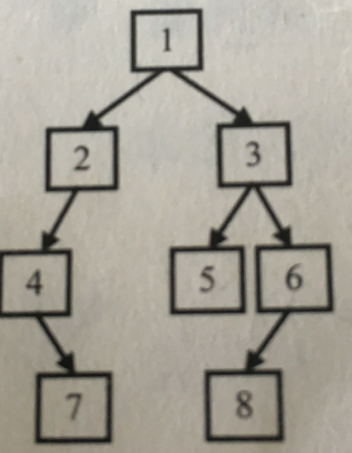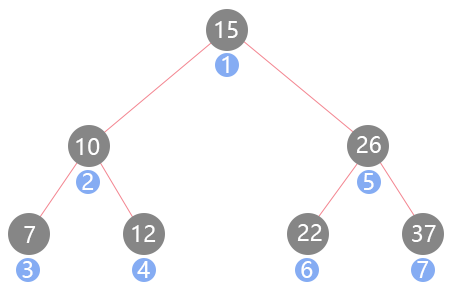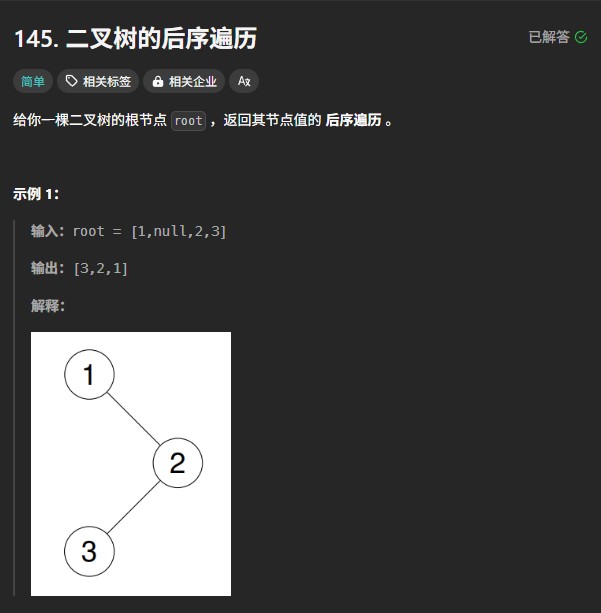题目:输入某二叉树的前序遍历和中序遍历的结果,请重建出该二叉树。假设输入的前序遍历和中序遍历的结果中都不含重复的数字。例如输入前序遍历序列{1,2,4,7,3,5,6,8}和中序遍历序列{4,7,2,1,5,3,8,6},则重建出图2.6所示的二叉树并输出它的头结点。

思路:因为前序遍历先访问根结点,所以我们可以从前序遍历序列中先找到根结点1,然后中序遍历先访问左子结点,再访问根结点,最后访问右子结点。所以根结点1的左边为左子树结点,右边为右子树结点。以此类推,通过递归可重建该二叉树。
测试用例:
1.普通二叉树(完全二叉树,不完全二叉树)。
2.特殊二叉树(所有结点都没有右子结点的二叉树,没有左子结点的二叉树,只有一个结点的二叉树)。
3.特殊输入测试(二叉树的根结点指针为NULL,输入的前序遍历序列和中序遍历序列不匹配)。
#include<iostream>
#include<cstdio>
using namespace std;
struct BinaryTreeNode
{
int m_nValue;
BinaryTreeNode* m_pLeft;
BinaryTreeNode* m_pRight;
};
BinaryTreeNode* ConstructCore(int* startPreorder, int* endPreorder,
int* startInorder, int* endInorder)
{
//前序遍历序列的第一个数字是根结点的值
int rootValue = startPreorder[0];
BinaryTreeNode* root = new BinaryTreeNode();
root->m_nValue = rootValue; //将值赋给头结点
root->m_pLeft = root->m_pRight = NULL; //把左右结点值设NULL
if (startPreorder == endPreorder) //前序遍历的头结点和尾结点相等,说明只有一个节点
{
if (startInorder == endInorder && *startPreorder == *startInorder)
{
return root;
}
else
{
throw exception("invalid input!");
}
}
//在中序遍历中找到根结点的值
int* rootInorder = startInorder;
while (rootInorder <= endInorder && *rootInorder != rootValue)
{
++rootInorder;
}
if (rootInorder == endInorder && *rootInorder != rootValue)
{
throw exception("invaild input!");
}
int leftLength = rootInorder - startInorder;
int* leftPreorderEnd = startPreorder + leftLength;
if (leftLength > 0)
{
//构建左子树
root->m_pLeft = ConstructCore(startPreorder + 1, leftPreorderEnd,
startInorder, rootInorder - 1);
}
if (leftLength < endPreorder - startPreorder)
{
// 构建右子树
root->m_pRight = ConstructCore(leftPreorderEnd + 1,
endPreorder, rootInorder + 1, endInorder);
}
return root;
}
BinaryTreeNode* Construct(int* preorder, int* inorder, int length)
{
if (preorder == NULL) || inorder == NULL || length <= 0)
{
return NULL;
}
return ConstructCore(preorder, preorder + length - 1, inorder,
inorder + length - 1);
}












